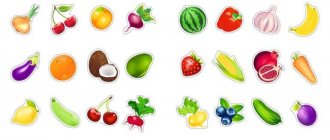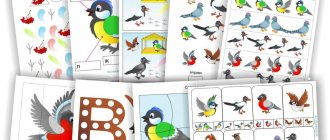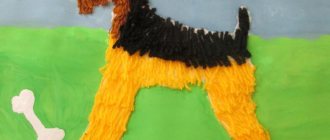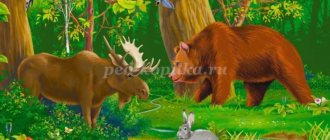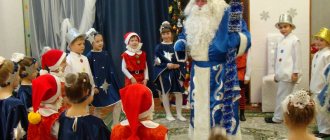Didactic games theme “Autumn”
Natalia Lazareva
Didactic games theme “Autumn”
Didactic games theme " Autumn "
Didactic game “Stocks of animals”
Objectives: improve the ability to select appropriate food for animals, develop attention, memory, and observation skills.
Attributes: pictures of animals, pictures of plants and mushrooms.
Game progress : 2 children play. One by one, they take a card with a picture of a plant or mushroom, say what it is, and put it next to the picture of a certain animal.
Note: the game can be individual.
Didactic game “What juice?”
(
“What kind of jam?”
)
Objectives: improve the ability to distinguish and name fruits, learn to form adjectives, develop oral speech, attention, memory.
Attributes: basket, pictures of fruits
Progress of the game : children take turns taking a picture from the basket, calling the pictured fruit and saying what the juice (or jam)
from this fruit. For example:
“This apple is apple juice.”
.
Didactic game “Which tree is the leaf from?”
Objectives: improve the ability to differentiate trees by their trunks and leaves, develop attention, observation, memory, imagination.
Attributes: trunks of three different trees drawn on separate sheets, autumn leaves of these trees.
Progress of the game : leaves lie scattered around the drawings of tree trunks. Children should
spread the leaves on your tree
Note: the game can be played in group or individual form.
Didactic game “Which sheet?”
Objectives: improve knowledge of distinguishing the leaves of three trees, learn to form adjectives, develop oral speech, attention, memory.
Attributes: basket, autumn leaves .
Progress of the game : children sit in a circle and pass the basket to each other. One by one they take out a piece of paper,
they say what tree it comes from and form an adjective. For example: this is a leaf from
birch - birch leaf.
Didactic game “Paired pictures”
Objectives: learn to correlate pairs of pictures according to the principle of “the whole and its part”
, develop logical thinking, attention, observation, oral speech.
Attributes: a set of paired pictures on an autumn theme , where in each pair of pictures a whole image is drawn on one, and on the other a separate part of it in the form of a separate object (for example: a bird on an autumn branch - an autumn branch ).
Progress of the game : 2 children play, one has a set of pictures with a whole image, the second has pictures with individual objects. One child takes any of his cards,
and the other must choose a steam room for her, explaining his choice. Then the second
Posts his picture, and the first child selects a match for it.
Note: the game can be individual.
Didactic game “Clap your hands”
Objectives: to consolidate the ability to hear the names of vegetables and fruits,
find them in pictures, develop auditory attention,
Attributes: subject pictures on the topic
Progress of the game : a poem is read, children must remember and name vegetables (or fruits, or berries, or mushrooms, depending on the topic that was mentioned in the poem, and show or post pictures from them
image. When the poem is read a second time, children
clap their hands if they hear the name of a vegetable (fruit, berries, mushrooms)
.
Didactic game . AUTUMN
1. "What happens in autumn ?"
Goal: consolidate the concept of autumn phenomena , activate the vocabulary on the topic.
Equipment: story pictures depicting different seasons.
Move. On the table are mixed pictures depicting various seasonal phenomena (it is snowing, a flowering meadow, an autumn forest , a starling in a birdhouse, etc.). The child chooses pictures that depict only autumn phenomena and names them himself or with the help of an adult. Example. The sun is hiding behind the clouds. It's raining. The leaves on the trees are yellow and red. Birds fly south. Animals are preparing supplies for the winter. People put on coats and raincoats, etc.
Autumn leaves » (lotto)
Goal: expand the vocabulary on the topic “ Autumn . Trees"
, teach how to correctly use nouns in the genitive case.
Equipment: autumn leaves of birch , oak, maple and linden, glued onto one large card, and onto separate cards.
Move. The game is played after getting acquainted with autumn leaves on a walk. There is a large card in front of the child. Small ones are stacked nearby. He takes one small card and determines which tree leaf he has: “This is a maple leaf.”
etc. Then he looks for the same sheet on a large card and places a small one on it. A non-speaking child is asked to find and show a leaf of a maple, birch, etc.
"Call me kindly"
Goal: learn to form nouns with diminutive suffixes.
Equipment: subject pictures depicting large and small vegetables.
Move. An adult shows the child a picture of a large vegetable, for example, a tomato, and asks what it is called. Then he explains: “This tomato is big. What would you affectionately call a small vegetable like this?” Shows a picture (tomato.)
Other vegetables are treated similarly (cucumber - cucumber, turnip - turnip, carrot - carrot, onion - onion, potato - potato). A non-speaking child is asked:
“Show me the tomato.
Now show me the tomato .
“Which vegetable did you miss?”
Goal: activation of vocabulary on the topic, development of attention and visual memory.
Equipment: toy “Hare”
, natural vegetables or dummies.
Move. The adult shows the child the hare and explains that today is his birthday. Guests came and brought many gifts. An adult places vegetable gifts in front of the hare, listing them. He doesn't name one vegetable. The child must guess which one. He names or shows it depending on the level of speech development.
